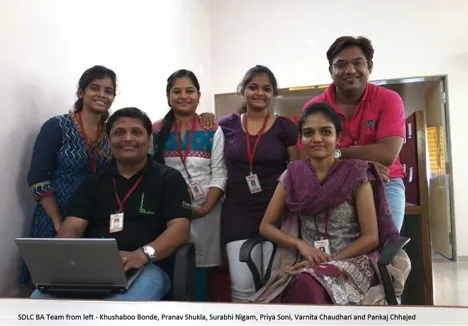How to lead a successful tech business from a small town: SDLC story
Far from the big-city glamourous world of startup culture, there are entrepreneurs toiling away in small towns with the sole aim of succeeding from their hometowns.

Pankaj Chhajed, who hails from Bhusawal in Maharashtra, dreamt of doing something different from his small town. He started with a vision to make a top analysis company of India and to empower the rural educated youth. Today, his startup, SDLC, has completed 3 successful years, 300+ projects globally and has 25-member strong team.
What does SDLC do?
SDLC Services Pvt. Ltd. is a provider of niche Business Analysis (BA), User Experience and User Interface Services in which software needs are defined and solution is recommended before actual software development.

Founded by Pankaj Chhajed, alumnus of ICT and JBIMS, Mumbai, the startup faced a difficult time in its first year. It failed to attract investors, recruit talent and find co-founders. But Pankaj’s dream of doing something in his native place was achieved through a lot of perseverance, hard work and dedicated efforts.
SDLC is now profitable, generates good revenue and is looking for strategic investment to fuel its growth by increasing service offerings, acquiring more clients, offering products in Business Analysis and UI / UX domain.
IT companies with in-house Business Analysis capability and independent consultants are their competitors. Their model is to provide BA support to the companies that don’t have Business Analysis skills.
SDLC’s edge
- Cost competitiveness - Starting in a small town helped them minimize resource cost, infrastructure cost and operational cost, and this benefit is transferred to their clients
- Domain knowledge - Their domain expertise is in Business Analysis, UI and UX
- 24*7 availability and Infrastructure - Though they are in a small town, they have good infrastructure in terms of office place, high-speed internet connectivity, conference rooms and 24*7 availability. This allows them to work in different time zones
- Quality of deliverable - They have a very high standard on-time and within budget deliverables to their clients
- Niche Services that supports software development - They provide all the services that compliments software development

Traction
Their prime consumers include software development companies and product companies. Apart from these, entrepreneurs who want to conceptualize their idea into prototype and mockup design are also their consumer. 90% of their revenue comes from USA and the UK.
They provide all the services that support software development that includes Requirement Analysis, Business Analysis, Functional and Technical Documentation, Product Analysis, User Interface & User Experience Design, Prototyping, and Functional Testing.
They are targeting IT companies, product companies and startups. These clients need formal Business Analysis skills but as these skills are rare and costly, they don't go for full time business analysts. Instead, they outsource these services. At present, they are not targeting Indian companies but will in the near future considering how the Indian product growth story progresses.
Almost 100% of their business comes from abroad. They are serving global clients and most of their business is through repeat projects from the same clients. Getting clients through social media and networking sites is not a costly affair and it’s faster than getting Indian clients. But now, they have plans to expand to Indian clients as well to fuel growth.
Benefits for consumers
- Helping clients reduce cost of software development and rework by providing detailed analysis documentations, User experience, Interface design and solution
- Client can see demo prototype before actually developing software
- Helping clients bridge the gap between the technology domain and the business domain
- Improve efficiency of development life cycle by simplifying complex business processes, documenting requirements and proposing a solution
- Reducing product risks by using methods, tools, techniques, and checklists selected specifically for the initiative that is being undertaken.
Small-town boy’s success
Pankaj believes that the ability to run a professional business is no longer limited by location.
What you need is a vision, mission and a burning desire to make it happen.

In the beginning, setting up a team and getting clients was very challenging. In the first year of the business operations, his focus was to get a few clients and start projects. He started working as an independent consultant initially and when he saw some traction happening he started recruiting engineers from nearby areas.They focused ‘On the Job Training’ to train the resources, and later developed a very strong business analysis training method that helped resources to acquire Business Analysis skills.
They now have a team that handles projects independently and is responsible for all client deliverables.
Small town helps the team stay united and strong as the attrition is very less. Pankaj considers that this trait provides stability to the team.
To keep the employees updated with the latest technological developments, they have formed a Centre of Excellence (COEs) in their team. It's a good initiative for the overall development of the employees.
Setting up teams in smaller towns
Going against the popular belief that setting up in smaller towns is difficult, Pankaj believes that it’s not very difficult to setup a team in a small town, however, it is a bit different.
The rapid scale of Internet penetration is fueling decentralization. The proliferation of open-source tools and cloud computing has made it possible to start a fast-growth company from virtually anywhere. And social media has given entrepreneurs a cheap and an easy way to access thousands of potential new customers from anywhere.
But as there are two sides of a coin, it is difficult for startups in many small towns to attract investors, recruit talent and find the right entrepreneurial resources to succeed.
But Pankaj believes that if one has fire in the belly to make it happen, it can happen from anywhere!
Changing trends
With changing requirements and market needs, Business Analysis is a must for organizations, and user experience/ interface is the key driver.
Business Analysis is moving away from documentation and is now more of visual representation of requirements through wireframing and prototype.
The team is witnessing more traction of Business Analysis in the product side where products are built keeping end user in mind to make more user-friendly products.
As the trend is towards products, Pankaj and his team is working towards evolving some of their services into products. They have a SaaS based product – myalma.in that is an official alumni web based product.
On the changing tides in the service industry, he states, “I cannot deny the fact that the trend is moving towards making products and making it operational. Products are easily scalable whereas the service- industry being resource based needs time to scale. But I am a strong believer of the fact that products have a short life cycle as compared to service-based startups. If products are growing in India then that will definitely generate good opportunities for service based industry.
This is a brilliant example of how entrepreneurs can leverage rural educated talent to create a world-class service based startups from smaller towns.
A great inspiration which validates the fact that India is changing and at a rapid pace.
Do check their website.







![[Product Roadmap] Transport management startup Chalo is using tech to make public transport reliable](https://images.yourstory.com/cs/2/a9efa9c02dd911e9adc52d913c55075e/Chalofeatureimage-11-1622549163715.png)